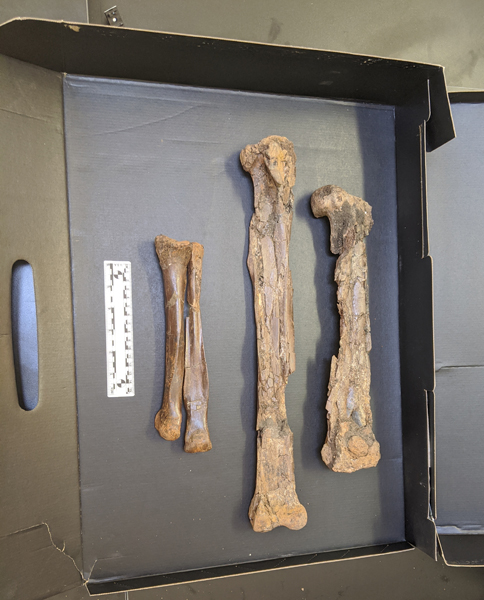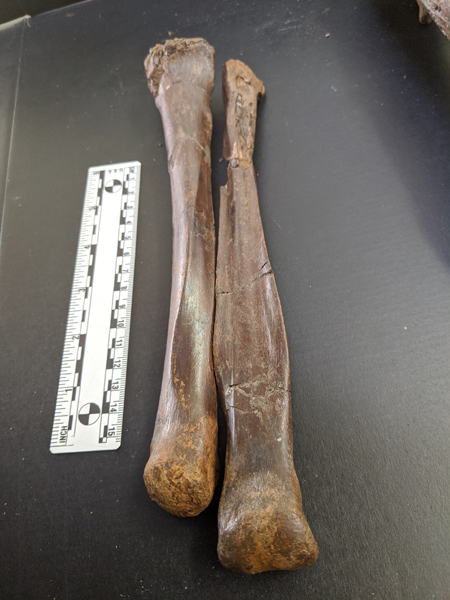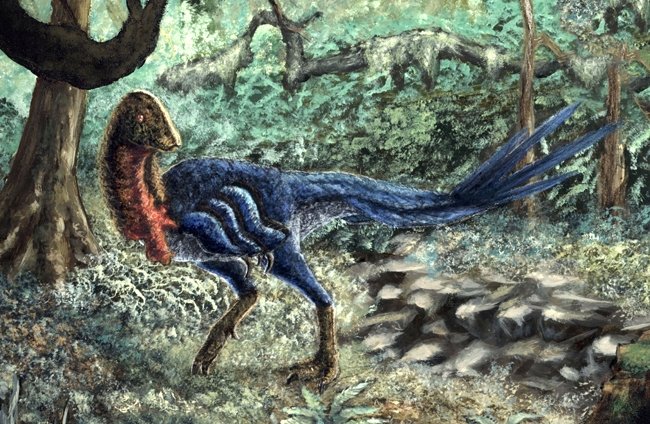To discover a new dinosaur species might mark the high point of a long career in palaeontology for some scientists. However, for one Oklahoma State University (OSU) student they can already put a tick in the “named a new dinosaur box” on their curriculum vitae. Kyle Atkins-Weltman (PhD student in the School of Biomedical Sciences), was studying a selection of foot and leg bone fossils of what was thought to be a juvenile Anzu wyliei. Remarkably, analysis of the fossils indicated that these bones came from a mature animal and as such they represented a new dinosaur species. Based on these findings, Kyle was able to erect a new Hell Creek theropod – Eoneophron infernalis.

The picture (above) shows limb bones from the newly described caenagnathid. Metatarsals (left) with the right tibia (centre) and a femur (right).
Pharaoh’s Dawn Chicken from Hell
Bone histology revealed the fossils to represent a dinosaur at least six years of age when it died. These were not the bones from a juvenile A. wyliei, but from a smaller but closely related theropod species. The student named the new dinosaur Eoneophron infernalis. It translates as “Pharaoh’s dawn chicken from Hell”. Team members at UK-based Everything Dinosaur pronounce this dinosaur as ee-on-oh-fron in-fur-nal-lis.
The name honours the description of the Anzu taxon as well as the student’s late beloved pet, a Nile monitor lizard named Pharaoh.

Eoneophron infernalis and Implications for Caenagnathid Diversity
Previously, only one caenagnathid (Anzu wyliei) was known from the Hell Creek Formation. It was formally named and described in 2014 (Lamanna et al). Palaeontologists were aware of smaller, fragmentary fossil bones representing caenagnathids from the Hell Creek Formation. It was unclear whether these fossils represented distinct, undescribed taxa or juvenile A. wyliei specimens. Eoneophron infernalis is estimated to have stood around one metre high at the hips and weighed approximately seventy kilograms. In contrast, Anzu wyliei was much larger, with a hip height of about 1.5 metres and weighing three hundred kilograms.
This new taxon is also distinct from other small caenagnathid material previously described from the area. Scientists postulate that there are potentially three distinct caenagnathid genera in the Hell Creek Formation. These results show that caenagnathid diversity in the Hell Creek ecosystem has probably been underestimated.

A Feathered Dinosaur
When asked to describe Eoneophron infernalis, Kyle highlighted how closely related to birds these dinosaurs were. He stated:
“It was a very bird-like dinosaur. It had a toothless beak and a relatively short tail. It’s hard to tell its diet because of the toothless beak. It definitely had feathers. It was covered in feathers and had wings.”
Co-author of the scientific paper and Kyle’s faculty advisor Associate Professor Eric Snively commented:
“Kyle is the first student researcher at OSU-CHS to reveal, describe and name a new dinosaur.”
When it looked like the fossils may not belong to an Anzu, Atkins-Weltman turned to caenagnathid researchers Greg Funston, PhD, a palaeontologist with the Royal Ontario Museum in Ontario, Canada, and palaeontology PhD candidate Jade Simons with the University of Toronto for their assistance.
He was also able to involve Associate Professor of Anatomy Dr Holly Woodward Ballard, an expert in bone histology.
A Thrilling Discovery
Kyle Atkins-Weltman explained that his project and published findings would not have been possible without his co-authors and those who assisted him.
He added:
“It was really thrilling. Based on the work and research I do, I never thought I would be someone to discover a new dinosaur species.”
Everything Dinosaur acknowledges the assistance of a media release from Oklahoma State University in the compilation of this article.
The scientific paper: “A new oviraptorosaur (Dinosauria: Theropoda) from the end-Maastrichtian Hell Creek Formation of North America” by Kyle L. Atkins-Weltman, D. Jade Simon, Holly N. Woodward, Gregory F. Funston and Eric Snively published in PLOS One.








Leave A Comment